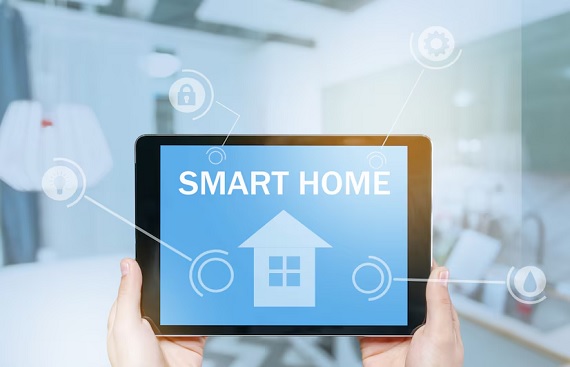The Effectiveness of Smart Home Security

In the world were technology is effortlessly integrated into our daily lives, the concept of the ‘smart home’ has transformed from a futuristic fantasy into a tangible reality. From controlling thermostats with smartphones to monitoring home security cameras from miles away, the digital age has ushered in a new era of convenience and connectivity. Central to this evolution is the advancement of smart home security technologies, which not only protect our homes but also provide peace of mind to homeowners. One of the most significant developments in smart home security is the integration of artificial intelligence (AI) and machine learning algorithms. These technologies enable devices to learn and adapt to patterns of behavior, allowing them to differentiate between normal household activities and potential security threats. For example, AI-powered cameras can distinguish between a family member entering the home and an intruder, sending alerts only when necessary. This level of intelligence not only reduces false alarms but also enhances the overall effectiveness of home security systems.
IoT Revolution in Smart Home Security
The Internet of Things (IoT) has transformed smart home security, enabling seamless integration among sensors, cameras, and locks. For example, a motion sensor can trigger a security camera to record while alerting the homeowner's smartphone. This connectivity enhances responsiveness and provides real-time control from anywhere. Innovative features like two-way audio/video smart doorbells and remote-controlled smart locks not only bolster security but also streamline daily tasks. However, privacy and data security remain paramount, prompting robust encryption and regulatory measures. Despite cybersecurity challenges, the future promises even more sophisticated solutions, from AI-powered surveillance to biometric authentication. As homeowners embrace these advancements, they can trust their smart homes to offer top-notch security and convenience in the digital age.
The Evolution of Smart Home Security
A home security system comprises a set of interconnected physical electronic components aimed at safeguarding a residence. As remote work became increasingly prevalent, individuals sought ways to enhance the comfort and adaptability of their homes. One popular method was integrating smart home devices, which provided greater control and flexibility over conventional functions. These devices encompassed a variety of innovations such as smart speakers, lightbulbs, video doorbells, security cameras, and beyond. Over time, this integration evolved into a comprehensive ecosystem of interconnected smart home devices.
Alok Hada, Director, Anusha Technovision Pvt. Ltd., says, "The term 'smart' is often used improperly when people talk about home technology. Lights that are programmed from your phone, window blinds that are automated, and video doorbells are all good as they help in creating a safer and comfier home. But home devices or appliances don’t become smart just because they are plugged into the internet. A more appropriate term for the technology we’d see today would be 'connected home'".
The advent of the smart home revolution heralds a future marked by seamless integration and automation, where every facet of our living spaces collaborates harmoniously to anticipate needs, enrich daily experiences, and optimize environmental impact. This entails simple tasks like adjusting lighting with voice commands, conserving energy, and remotely managing security systems, presenting a vast array of possibilities. At the heart of this transformation lies artificial intelligence (AI), empowering voice assistants like Alexa and Siri to become increasingly intuitive, learning from user behaviors to tailor automated routines to individual preferences. From regulating home temperatures to orchestrating grocery deliveries, AI-driven assistants streamline tasks and elevate convenience.
Security cameras: Intelligent security cameras connect to Wi-Fi, allowing users to remotely stream footage from their systems and receive alerts when motion, individuals, or packages are detected. Numerous cameras offer features like infrared or color night vision, as well as options for cloud or local storage. Also, they may include two-way audio capabilities, enabling communication with individuals captured on camera. Certain models integrate with popular platforms such as Amazon Alexa or Google Assistant.
Motion sensor: Ideally positioned in main entryways or ground-floor hallways, motion sensors detect movement and trigger alerts when the security system is armed. Some models feature pet-sensitive settings to prevent false alarms caused by pets moving within the monitored area.
Entry sensor: Also referred to as contact sensors, entry sensors consist of two parts: one attached to the window or door and the other to the frame. These sensors utilize magnets to determine when an entrance is opened or closed. If the sensor detects an open entry point, it triggers an alert. For optimal placement, we recommend installing entry sensors on ground-floor windows or doors. Most entry sensors are battery-operated and feature adhesive backings for simple installation.
Glass break sensor: In situations where intruders opt to break windows rather than open them conventionally, glass break sensors come into play. These sensors detect the sound of glass breaking and promptly notify us via mobile alerts.
Siren: Sirens are integral components of home security systems, either standalone or integrated into other devices such as the base station. Sirens are typically activated simultaneously with other alarms and serve to either deter intruders or alert neighbors to potential threats.
E-informer: An intelligent and self-sufficient electronic device designed to offer continuous security surveillance for various premises such as homes, offices, shops, banks, and hospitals, among others, throughout the day. Besides ensuring unmanned intrusion detection for peace of mind, it can also identify and alert about potential fire, smoke, or gas leaks. The device promptly notifies pre-set phone numbers via both call and SMS, while also emitting high-decibel audio alarms to draw attention to potential threats.
Final Note
As AI reshapes our interactions with technology, there's a growing acceptance among smart home users toward integrating Internet of Things (IoT) devices, further propelling the evolution towards interconnected and intelligent living spaces.
